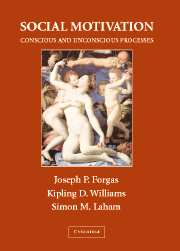Book contents
-
Frontmatter
-
Contents
-
About the Editors
-
List of Contributors
-
Preface
-
The Sydney Symposium of Social Psychology series
- 1
Social Motivation: Introduction and Overview
- PART I
CONSCIOUS AND UNCONSCIOUS SOCIAL MOTIVATION: GENERAL ISSUES
- PART II
SOCIAL MOTIVATION: COGNITIVE AND AFFECTIVE IMPLICATIONS
- PART III
CONSCIOUS AND UNCONSCIOUS SOCIAL MOTIVATION: SOME CONSEQUENCES AND APPLICATIONS
- 14
Self-Regulatory Processes in Interracial Interactions: The Role of Internal and External Motivation to Respond without Prejudice
- 15
Exploring the Discrepancy Between Implicit and Explicit Prejudice: A Test of Aversive Racism Theory
- 16
Ostracism: When Competing Motivations Collide
- 17
Attentional and Regulatory Mechanisms of Momentary Work Motivation and Performance
- 18
Social Motivation and Object Relations: Narcissism and Interpersonal Self-Esteem Regulation
- 19
To Know or Not to Know: Consciousness, Meta-consciousness, and Motivation
-
Author Index
-
Subject Index
- References
16 - Ostracism: When Competing Motivations Collide
Published online by Cambridge University Press: 04 August 2010
- Frontmatter
- Contents
- About the Editors
- List of Contributors
- Preface
- The Sydney Symposium of Social Psychology series
- 1 Social Motivation: Introduction and Overview
- PART I CONSCIOUS AND UNCONSCIOUS SOCIAL MOTIVATION: GENERAL ISSUES
- PART II SOCIAL MOTIVATION: COGNITIVE AND AFFECTIVE IMPLICATIONS
- PART III CONSCIOUS AND UNCONSCIOUS SOCIAL MOTIVATION: SOME CONSEQUENCES AND APPLICATIONS
- 14 Self-Regulatory Processes in Interracial Interactions: The Role of Internal and External Motivation to Respond without Prejudice
- 15 Exploring the Discrepancy Between Implicit and Explicit Prejudice: A Test of Aversive Racism Theory
- 16 Ostracism: When Competing Motivations Collide
- 17 Attentional and Regulatory Mechanisms of Momentary Work Motivation and Performance
- 18 Social Motivation and Object Relations: Narcissism and Interpersonal Self-Esteem Regulation
- 19 To Know or Not to Know: Consciousness, Meta-consciousness, and Motivation
- Author Index
- Subject Index
- References
Summary
INTRODUCTION
In a recent investigation into the causes of 15 school shootings in the United States, Leary, Kowalski, Smith, and Phillips (2003) found that acute or chronic rejection in the form of ostracism, bullying, or romantic rejection was a significant factor in all but two cases, and concluded that these rejection experiences had motivated many of the shooters to behave violently, either as a way of achieving retribution against the rejecting group or gaining social respect. Laboratory research has also shown that in certain circumstances, individuals who experience social exclusion are more likely to exhibit aggressive behaviors than those who are included (Twenge, Baumeister, Tice, & Stucke, 2001; Twenge & Campbell, 2003). As a rather extreme example (hopefully), a recent newspaper article (“Put to the Sword” in The Australian, June 23, 2003) reported on a Thai woman who killed her husband before slicing off his penis, boiling it, and then hanging herself. In her suicide note, she indicated that she was saddened by the fact that her husband had ignored her. Clearly, the act of excluding or rejecting another can have profound motivational consequences for the target, and these motivations may lead to antisocial and even aggressive behaviors.
Conversely, many individuals experience social ostracism on a daily basis without showing any signs that they are being driven by aggressive or antisocial motives (Williams, 2001).
- Type
- Chapter
- Information
-
Social MotivationConscious and Unconscious Processes, pp. 294 - 313Publisher: Cambridge University PressPrint publication year: 2004
References
- 2
- Cited by



